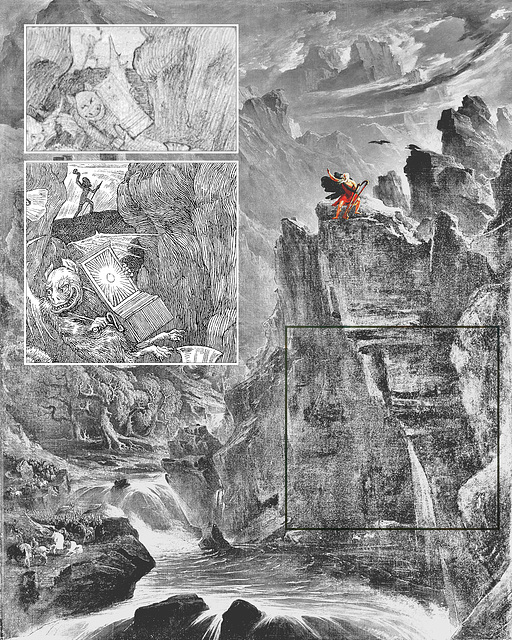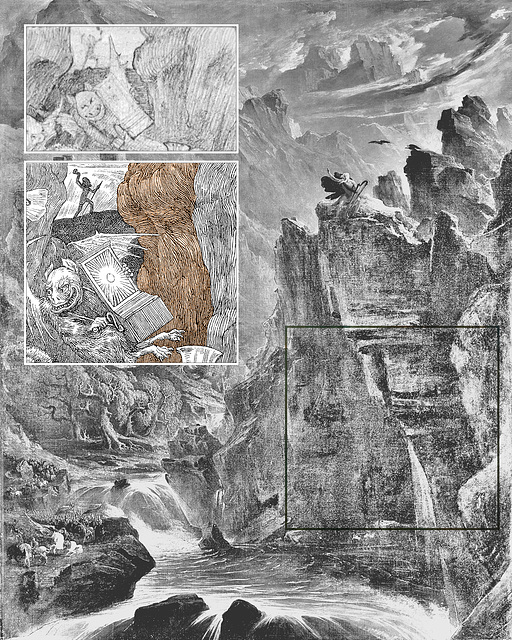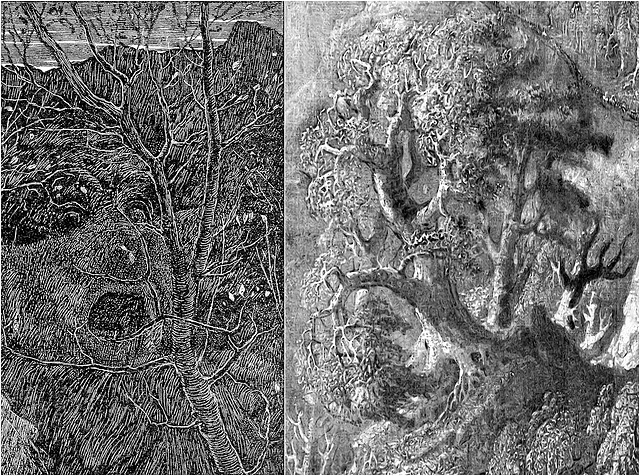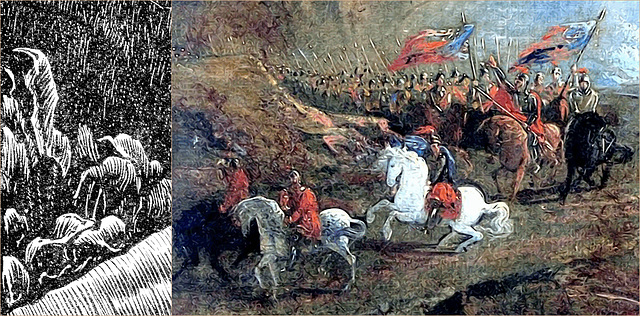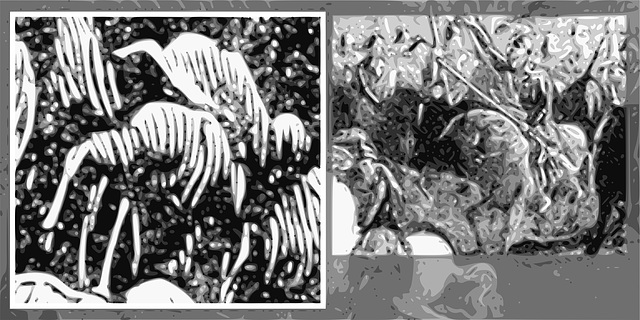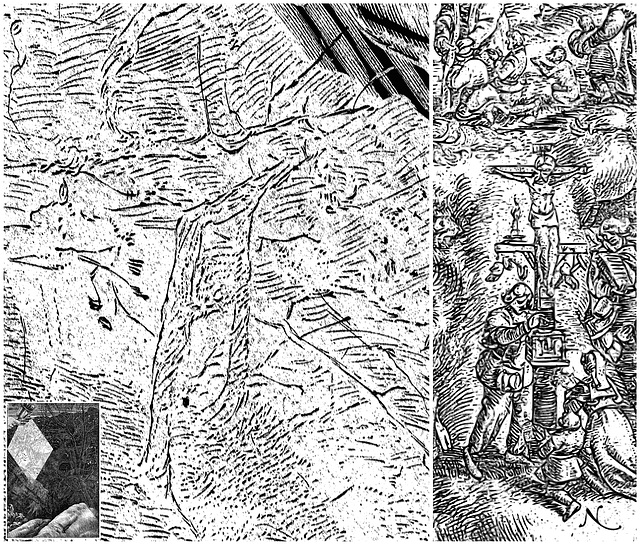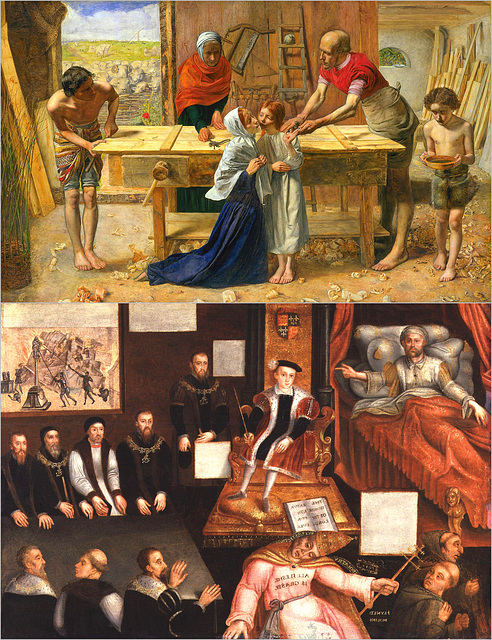
The Art of Deniability
Folder: The Hunting of the Snark
How to avoid trouble: Hold the beholder of your images responsible for what they "see".
01 Jun 2013
3 comments
The Paranoiac-Critical Method serves the Art of Deniability
Ceci n'est pas un cigare.
Hendry Holiday was an underestimated artist.
In Lewis Carroll's The Hunting of the Snark , Holiday made sure that it is you who will be hold responsible for your perceptions. Both, Holiday and Carroll/Dodgson, were masters of the art of deniability. They applied the " paranoiac-critical method " a few years before Dalí invented it to pull our legs.
Holiday's illustration to the last Snark chapter:
See also: www.academia.edu/9907524/The_Art_of_Deniability
05 Jan 2014
4 comments
Bellman & Bard after retinex filtering
[main image]: John Martin: The Bard (ca. 1817) , by GIMP: contrast enhanced in the rock area & light areas delated & (most of) color removed & retinex filtering
[upper inset]: Detail from preperatory draft for Henry Holiday's illustration (1876) to chapter The Beaver's Lesson in Lewis Carroll's The Hunting of the Snark
[lower inset]: Henry Holiday: Illustration (1876) to chapter The Beaver's Lesson in Lewis Carroll's The Hunting of the Snark , detail
It seems, that initially Henry Holiday saw anthropomorphic "faces" in John Martin's rocks and used them in his draft. However, Holiday's final allusion to this part of John Martin's painting is different - and funnier.
As the for The Bard , the final Bellman comes closer to that figure than the drafted Bellman.
=== Literature ===
In mydailyartdisplay.wordpress.com/the-bard-by-john-martin , "Jonathan" connects the painting to the poem The Bard written by by Thomas Gray in 1755. Inspired by a Welsh tradition that said that Edward I had put to death any bards he found, to extinguish Welsh culture; the poem depicts the escape of a single bard:
· · ...
· · On a rock, whose haughty brow
· · Frowns o'er cold Conway's foaming flood,
· · Robed in the sable garb of woe
· · With haggard eyes the Poet stood;
· · ...
· · A Voice, as of the Cherub-Choir,
· · Gales from blooming Eden bear;
· · And distant warblings lessen on my ear,
· · That lost in long futurity expire.
· · Fond impious Man, think'st thou, yon sanguine cloud,
· · Rais'd by thy breath, has quench'd the Orb of day?
· · To-morrow he repairs the golden flood,
· · And warms the nations with redoubled ray.
· · "Enough for me: With joy I see
· · The different doom our Fates assign.
· · Be thine Despair, and scept'red Care,
· · To triumph, and to die, are mine."
· · He spoke, and headlong from the mountain's height
· · Deep in the roaring tide he plung'd to endless night.
· · ...
Full text:
www.thomasgray.org/cgi-bin/display.cgi?text=bapo
spenserians.cath.vt.edu/TextRecord.php?action=GET&tex...
www.english.upenn.edu/~mgamer/Etexts/gray.bard.html
www.google.com/search?q="A+Voice,+as+of+the+Cherub-Choir"
The poem and the painting may have been an inspiration to Lewis Carroll and Henry Holiday in The Hunting of the Snark . This is about The Vanishing of The Baker :
· · 537 · · "There is Thingumbob shouting!" the Bellman said,
· · 538 · · · · "He is shouting like mad, only hark!
· · 539 · · He is waving his hands, he is wagging his head,
· · 540 · · · · He has certainly found a Snark!"
· · 541 · · They gazed in delight, while the Butcher exclaimed
· · 542 · · · · "He was always a desperate wag!"
· · 543 · · They beheld him--their Baker--their hero unnamed--
· · 544 · · · · On the top of a neighbouring crag.
· · 545 · · Erect and sublime, for one moment of time.
· · 546 · · · · In the next, that wild figure they saw
· · 547 · · (As if stung by a spasm) plunge into a chasm,
· · 548 · · · · While they waited and listened in awe.
Album:
John Martin
21 Sep 2014
4 comments
Fun with Allusions
I think that Henry Holiday had quite some fun in imagining how the beholders of his illustrations would deal with what they might see. And the cannot hold him responsible for what they see.
26 Dec 2012
1 favorite
2 comments
Gnarly Monstrance
From his eeriest illustration to The Hunting of the Snark , Henry Holiday alluded to an monstrance-like simulacrum in John Martin's The Bard .
[left] Henry Holiday: Illustration (1876) to chapter The Vanishing in Lewis Carroll's The Hunting of the Snark , detail
[right] John Martin: The Bard (ca. 1817), mirror view of a horizontally compressed detail.
30 Nov 2012
3 comments
Weeds turned Horses (BW)
Dithered B&W graphics, optimized fpr printing:
105 x 82 mm at 1200 dpi or 210 x 164 mm at 600 dpi
(1) Henry Holiday: "The Vanishing"
Illustration to Lewis Carroll's "The Hunting of the Snark" (1876), lower half
(2) John Martin: "The Bard" (detail)
commons.wikimedia.org/wiki/File:John_Martin_-_The_Bard_-_Google_Art_Project.jpg
ca. 1817
Yale Center for British Art
Based on a Thomas Gray poem, inspired by a Welsh tradition that said that Edward I had put to death any bards he found, to extinguish Welsh culture; the poem depicts the escape of a single bard.
31 Mar 2014
2 favorites
4 comments
Herbs & Horses
[left]: Henry Holiday: The Vanishing (detail from lower left side)
Illustration to Lewis Carroll's "The Hunting of the Snark" (1876)
[right]: John Martin: The Bard (retinex filtered and vectorized detail from lower left side)
commons.wikimedia.org/wiki/File:John_Martin_-_The_Bard_-_Google_Art_Project.jpg (ca. 1817)
01 Jan 2013
2 comments
Weeds turned Horses (detail)
[left]: Henry Holiday: "The Vanishing" (detail)
Illustration to Lewis Carroll's "The Hunting of the Snark" (1876), lower left side
[right]: John Martin: "The Bard" (detail)
commons.wikimedia.org/wiki/File:John_Martin_-_The_Bard_-_Google_Art_Project.jpg (ca. 1817), lower left side
23 Jun 2013
1 comment
"But if ever I meet with a Boojum, that day, I shall softly and suddenly vanish away."
Patterns from an illustration by Henry Holiday (and Joseph Swain) to the chapter The Vanishing in Lewis Carroll's The Hunting of the Snark (1876) and a segment of the Allegory of Iconoclasm (or The Image Breakers ) by Marcus Gheeraerts the Elder (c. 1567).
(1st version on Flickr: 2010-08-24 )
18 Mar 2012
1 comment
Carpenters Shop and Millais' Allusions
Finding Millais' allusions to an anonymous painter is a "bycatch" of my Snark hunt.
[top]: John Everett Millais : Christ in the House of His Parents aka The Carpenter's Shop (1850).
Location: Tate Britain (N03584) , London.
Literature:
* Deborah Mary Kerr (1986): John Everett Millais's Christ in the house of his parents ( circle.ubc.ca/handle/2429/26546 )
p.34 in (01) Éva Péteri (2003): Victorian Approaches to Religion as Reflected in the Art of the Pre-Raphaelites, Budapest 2003, ISBN 978-9630580380 (shortlink: www.snrk.de/EvaPeteri.htm )
* Albert Boime (2008): Art in an Age of Civil Struggle, 1848-1871
p. 225-364: The Pre-Raphaelites and the 1848 Revolution ( en.wikipedia.org/wiki/Special:BookSources/0226063283 )
[bottom]: Anonymous : Edward VI and the Pope , An Allegory of Reformation, mirrored view (16th century, NPG 4165 ). Iconoclasm depicted in the window. Under the "window" 3rd from left is Thomas Cranmer who wrote the 42 Articles in 1552.
Edward VI and the Pope (NPG 4165) was, until 1874, the property of Thomas Green, Esq., of Ipswich and Upper Wimpole Street , a collection 'Formed by himself and his Family during the last Century and early Part of the present Century' (Roy C. Strong: Tudor and Jacobean Portraits , 1969, p.345). Thus, when Millais' Christ in the House of His Parents ('The Carpenter's Shop') was painted in 1849-1850, the 16th century painting was part of a private collection. It was sold by Christie's 20 March 1874 (lot 9) to a buyer unknown to me, that is, when Holiday started with his illustrations to The Hunting of the Snark .
Location: National Portrait Gallery, London
Jump to top
RSS feed- Latest items - Subscribe to the latest items added to this album
- ipernity © 2007-2024
- Help & Contact
|
Club news
|
About ipernity
|
History |
ipernity Club & Prices |
Guide of good conduct
Donate | Group guidelines | Privacy policy | Terms of use | Statutes | In memoria -
Facebook
Twitter



